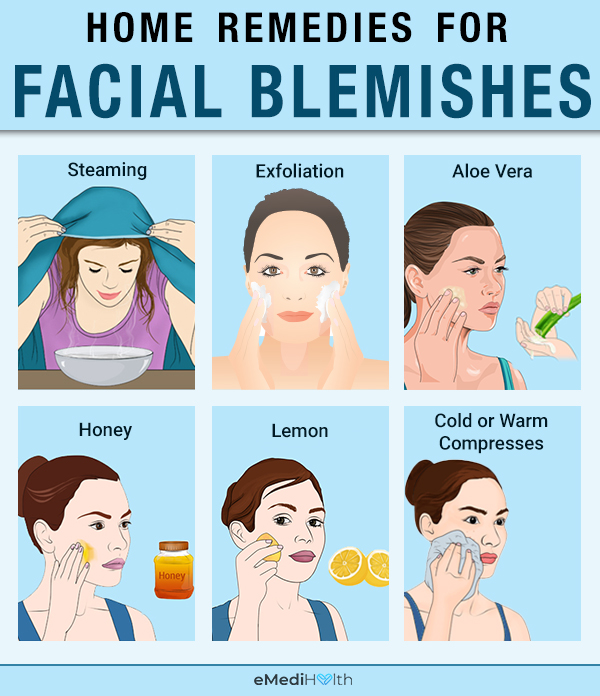Home Remedies for Facial Blemishes
Written by Jessica Lal on March 2, 2023
A blemish appears in the form of a spot, patch, or discoloration on the skin. While they are generally not a health problem, facial blemishes can make you conscious of your looks.
There are various preventive measures and home remedies that you can try to help improve the appearance of such spots.
Home Remedies for Blemishes

You can do several things at home to help manage blemishes.
Patch test: Before trying any of the topical remedies on your face, do a patch test by applying a small amount on the underside of your arm to rule out the risk of skin irritation or other side effects.
1. Try steaming
Steaming is a gentle heat therapy that is commonly used to open up plugged pores to facilitate the expulsion of their trapped content. This age-old technique can easily be performed at home and can help deeply cleanse your congested skin pores
Certain pore-cleaning tools are available as well that can be used to extract the contents of the blocked pore after steaming.
2. Exfoliate your skin
The accumulation of dead skin cells in your pores is a major contributing factor to the development of acne, which is why it is crucial to exfoliate your skin from time to time.
Mechanical exfoliation usually entails the use of liquid scrubs with granules or cloths that gently remove the dead skin cells.
Chemical exfoliants include salicylic acid and glycolic acid, which accelerate the shedding of the topmost layer of dead, damaged skin to reveal fresh, new layers of spotless skin. Ask your dermatologist to recommend the safest and most appropriate exfoliating agent for your skin type and condition.
3. Use aloe vera gel
The skin benefits of aloe vera gel have been widely acknowledged but need further scientific validation. This naturally occurring emollient may help moisturize the skin and protect it from sun-induced UV damage.
Aloe vera is credited with significant skin-healing potential. It also keeps the skin hydrated, helping to preserve its structural integrity.
How to use:
Massage fresh aloe vera gel on your face or use aloe vera-based creams.
4. Apply honey
Honey may help fade scars. However, there isn’t enough scientific evidence to substantiate this claim. Broad-based studies are required to establish the efficacy of honey for the treatment of scars.
How to use:
Warm 2 tablespoons of honey and gently apply it to your face. Wash your face after 10 minutes and pat it dry. You can also add a bit of turmeric to the honey, which can add to the anti-inflammatory, antiseptic, and antioxidant effects of this remedy.
Caution: Turmeric is a potent ingredient that may not suit everyone. So, conduct a patch test before applying it to your acne-ridden face, and stop its use if you notice any adverse reaction.
5. Use lemon
Vitamin C is a potent antioxidant that offers a variety of skin benefits, including the treatment of hyperpigmentation, premature skin aging, and other types of blemishes. However, further research is needed to conclusively establish this dermatological claim.
Lemon is a rich reserve of vitamin C and may help diminish the appearance of blemishes with repeated application. In fact, lemon juice has been part of many anecdotal topical home treatments for fading spots and blemishes.
Caution: The application of vitamin C-containing creams causes certain oxidative changes in the skin. Given that the skin around the eyes is thinner than your normal skin, extra precaution is recommended when applying vitamin C or any cream in such delicate areas.
6. Try cucumber
Cucumber is loaded with antioxidants and vitamin C that help improve skin health.
How to use:
Soak a cotton ball in fresh cucumber juice and apply it to your skin. Leave it on for 20 minutes and wash the area using cold water after.
7. Apply cold and warm compresses
If you really must do something about your pimple beyond washing your face and spot treating, a cold compress can help. This gentle cold therapy helps reduce the pain, redness, and swelling associated with inflammatory acne.
How to use:
Wrap an ice cube in a soft tissue or cloth and place it on your acne for 20–30 seconds at a stretch, a few times a day.
Caution: Never apply the ice cube directly to the skin, as the intense cold can further damage the tissue and even lead to frostbite.
You can also use a warm compress to draw out the pus from a pimple so that it heals quickly. When you apply mild heat onto the deep-seated zit, the pus travels upward and it forms a head.
How to use: Simply dip a clean washcloth in moderately warm water and then wring out the excess fluid. Ensure that the damp cloth isn’t too hot for your skin before applying it to your face.
8. Use tomatoes
Tomatoes possess astringent properties that help shrink large pores and treat acne. However, there are no studies on the use of tomatoes for treating blemishes.
How to use:
Massage tomato pulp on your face and leave it on for 15 minutes. Rinse with cool water.
9. Apply apple cider vinegar
Apple cider vinegar (ACV) has been anecdotally used for acne treatment, but there is no scientific evidence to confirm its effectiveness and safety.
The alkaline nature of ACV may help tone the skin and improve its pH balance when applied topically, while its antimicrobial properties can help curb the growth of acne-causing bacteria.
When taken orally, ACV can help reduce the acidic environment inside the body to make it less conducive to bacterial growth. It also provides infection-fighting probiotics to reduce the severity and frequency of acne breakouts.
How to use:
People with acne-prone skin can use ACV as a mild antiseptic toner.
- Simply dilute half a cup of ACV in the same amount of water in a glass container.
- Pour the liquid in a sterile bottle and then give it a shake so that solution mixes well.
- Pour a few drops onto a clean cotton ball, and use it to gently wipe your face but only after washing.
Caution: Make sure to dilute ACV before using it.
10. Use zinc
Zinc helps regulate the production of sebum by acting on the androgenic hormones such as testosterone.
How to use:
- Add more foods that are rich in zinc to an overall healthy, well-balanced diet. Some of the best dietary sources of zinc include dried watermelon seeds, oysters, fortified cereals, beans, potatoes, roast beef, and lamb.
- If you fail to meet your required intake of zinc through foods, ask your doctor to put you on a zinc supplement.
- You can also apply zinc-containing creams, but consult your dermatologist about the proper usage.







